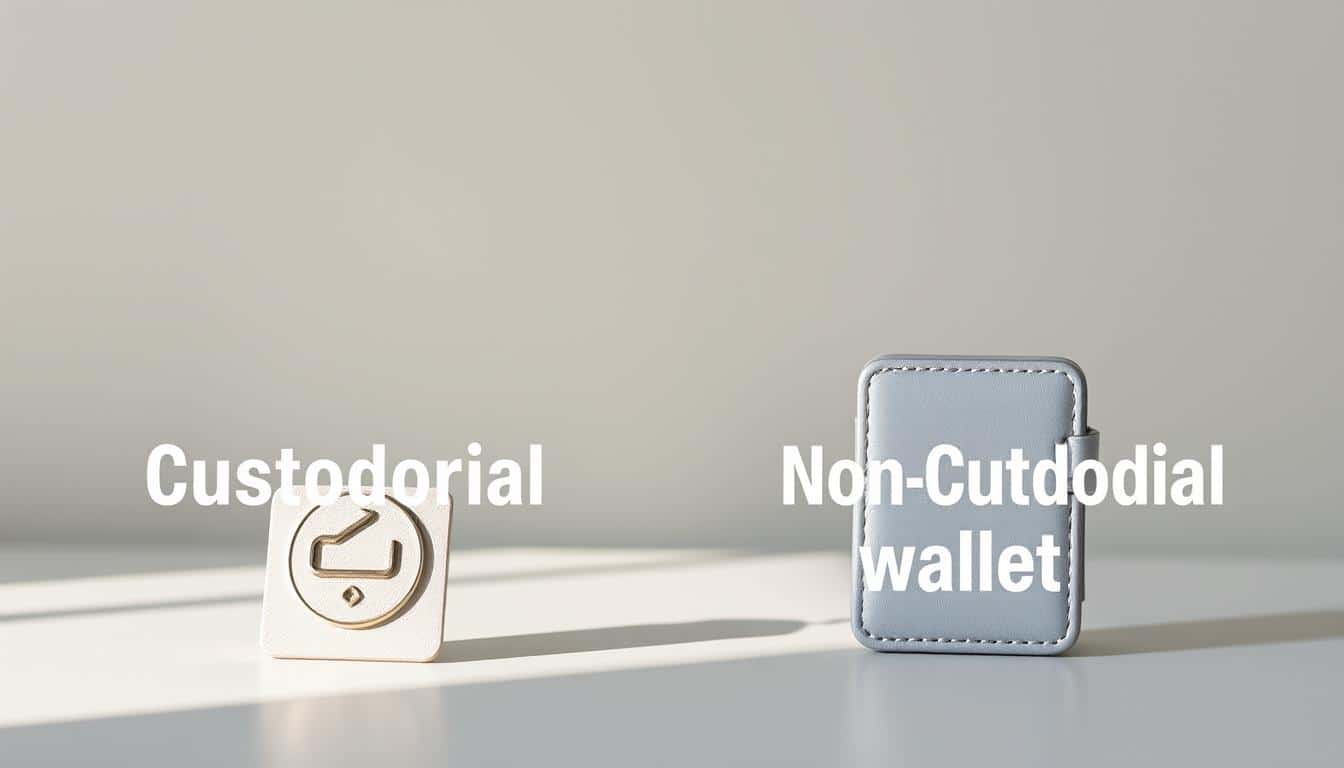Over 60% of crypto holders have lost access to their assets at some point. This can happen due to forgotten passwords or lost private keys. I almost locked myself out of my wallet last year.
The choice between custodial and non-custodial options isn’t just about technology. It’s about how much responsibility you want to carry. It’s also about who you trust with your crypto assets.
Different blockchain wallet types serve different needs. There’s no one-size-fits-all answer. The SEC’s recent guidance allows platforms like Coinbase to serve as qualified custodians. This changes the landscape a bit.
I’ll share what I’ve learned through actual use, not just theory. We’ll look at real platforms and discuss important trade-offs. This will help you figure out which approach suits your situation best.
Key Takeaways
- Custodial wallets let platforms manage your private keys, offering convenience but requiring trust in third-party services
- Non-custodial wallets give you complete control over your assets, but you’re solely responsible for security and recovery
- The SEC’s September 30 guidance established clearer regulatory standards for crypto custodians under the Investment Advisers Act
- Security features like cold storage, 2FA, and API key management vary significantly across different wallet platforms
- Your choice should depend on factors like technical expertise, asset amounts, and how frequently you trade
- Many experienced users employ both types for different purposes rather than choosing just one approach
Understanding Cryptocurrency Wallets
Crypto wallets differ from traditional money storage. They don’t hold your funds directly. Instead, they store cryptographic keys that prove ownership of blockchain addresses.
Many newcomers expect wallets to work like bank accounts. They assume password resets and customer service are available. This mindset quickly breaks down in decentralized systems.
What is a Crypto Wallet?
A crypto wallet stores keys, not coins. Your actual cryptocurrency lives on the blockchain, spread across many computers worldwide. It’s more like a keychain than a wallet.
You’re securing private keys in cryptocurrency. These are long codes that allow transactions from your addresses. Without these keys, your crypto becomes inaccessible forever.
The wallet interface manages your keys. It generates them, keeps them safe, and sends signed transactions to the network. Some wallets simplify this process, while others show more details.
Types of Crypto Wallets
Blockchain wallet types have grown since Bitcoin’s early days. Each type balances security, convenience, and features differently.
Here’s what I’ve seen in practice:
- Software wallets run as applications on your phone, computer, or browser. They’re convenient for regular transactions but only as secure as the device they’re installed on.
- Hardware wallets look like USB drives and keep your private keys isolated from internet-connected devices. I consider these essential for significant holdings.
- Exchange-hosted wallets are managed by cryptocurrency platforms. They offer simplicity but require trusting a third party with your keys.
- Web wallets operate entirely through browsers, accessible from anywhere but potentially vulnerable to phishing attacks.
- Paper wallets are physical documents with printed keys. I don’t recommend them anymore — too many ways for things to go wrong with ink degradation and physical loss.
Wallets can be custodial or non-custodial. This distinction matters more than the wallet type. It’s key to any crypto wallet security comparison.
Importance of Wallet Security
Wallet security isn’t just about stopping hackers. It’s about understanding control and balancing convenience with sovereignty. Good security protects your keys from external threats and your mistakes.
When comparing wallet security, I look at industry-standard practices. These include two-factor authentication, biometric logins, and encrypted storage. Cold storage and API key management are also important.
Here’s how security features typically compare:
| Security Feature | Purpose | Implementation Type | User Impact |
|---|---|---|---|
| Two-Factor Authentication | Prevents unauthorized access | Universal standard | Adds login step |
| Biometric Login | Convenient authentication | Device-dependent | Faster access |
| Encrypted Storage | Protects key data | Backend security | Invisible to users |
| Cold Storage | Offline asset protection | Custodial services | Withdrawal delays |
Most modern wallets have security features. The real challenge is understanding who controls recovery when problems occur. This became clear when my friend lost their seed phrase.
Your seed phrase is a master key for all your private keys. Losing it with a non-custodial wallet means losing your crypto forever. No customer service can help you recover it.
The security choice comes down to trust. Do you trust yourself with full control or a company to manage security? Both have profound implications worth considering before committing significant assets.
What are Custodial Wallets?
Custodial wallets are like traditional banks for cryptocurrency. Someone else manages the security while you log in and use your funds. When you buy Bitcoin on Coinbase or Binance, you’re using a custodial wallet.
This represents the centralized vs decentralized wallets divide. You’re trusting a third party rather than managing everything yourself. It’s similar to how most people interact with financial services.
How Custodial Services Work
Custodial wallets let you access crypto through standard login credentials. You get a username and password, just like your online banking account. The platform manages wallet addresses, transaction signing, and security protocols.
I’ve used custodial wallets for active trading accounts for years. They offer immediate access without needing to connect a hardware device every time. The convenience is hard to beat for frequent transactions.
Recent regulatory developments have added clarity to this space. SEC guidance from September 30 established that state-chartered trust companies can serve as qualified custodians. These custodians must maintain policies to safeguard crypto assets from theft, loss, and misappropriation.
Qualified custodians must conduct annual reviews of audited financial statements. They must segregate client assets from their own balance sheet. Custodial agreements must prohibit lending client assets without direct consent.
Benefits and Drawbacks
Custodial wallets are great for crypto newcomers. You don’t have to worry about losing a seed phrase and access to your funds. If you forget your password, there’s a recovery process.
For institutional investors, regulatory oversight adds legitimacy. This crypto wallet ownership control structure allows companies to hold crypto while meeting fiduciary requirements. But there are risks to consider when using custodial services.
- Security breaches: Exchange hacks have resulted in billions of dollars in losses over the years
- Business continuity: If the exchange goes bankrupt, accessing your funds becomes complicated or impossible
- Account restrictions: The platform can freeze your account for various reasons
- Counterparty risk: You’re trusting the company’s business practices and financial stability
The self-custody vs exchange wallets debate is about which types of risks you’re willing to accept. Exchange custody carries platform risk, while self-custody carries personal responsibility risk.
I’ve seen people affected by both frozen accounts and lost seed phrases. Neither situation is pleasant, and both can result in permanent loss of funds.
Leading Custodial Platforms
Several major platforms dominate the custodial wallet market. Each has distinct characteristics worth considering:
- Coinbase: Largest US-based exchange with insurance coverage and strong regulatory compliance history
- Binance: World’s largest exchange by trading volume, offering extensive cryptocurrency selection
- Kraken: Known for robust security practices and transparent proof-of-reserves reporting
- Cash App: Simplified Bitcoin-only option integrated with payment services
Each platform has different security practices, insurance policies, and track records. Research before committing significant value. I use multiple custodial services for different purposes.
Using custodial wallets means prioritizing convenience over direct control of your private keys. For many use cases, especially smaller amounts or active trading, that’s a reasonable trade-off.
What are Non-Custodial Wallets?
I switched to non-custodial storage after the FTX collapse. I felt uneasy about counterparty risk for assets I wasn’t actively trading.
Non-custodial wallets flip the custodial model upside down. You become the sole keeper of your funds. This approach means complete ownership and complete responsibility.
No one can freeze your account or limit withdrawals. But no one can help if you lose your credentials. It’s a trade-off requiring honest self-assessment of your skills.
How Non-Custodial Wallets Actually Work
In non-custodial wallets, you control the private keys in cryptocurrency. The wallet generates these keys locally on your device.
When setting up, it creates a seed phrase—usually 12 or 24 random words. This phrase is your master backup for recreating your wallet if needed.
I keep my seed phrase in a fireproof safe at home. I have a second copy elsewhere. It’s standard practice for serious crypto wallet owners.
Non-custodial approaches rely on users controlling their private keys. Security depends on individual practices rather than corporate infrastructure.
Platforms suggest security measures like read-only API keys and proper seed phrase storage. They note, “no platform is hack-proof”—making non-custodial storage appealing for long-term holdings.
The Real Advantages and Drawbacks
The advantages of non-custodial wallets are significant and concrete:
- True ownership: Your crypto exists independently of any company’s solvency or business decisions
- Censorship resistance: No authority can freeze, seize, or restrict your funds
- Elimination of counterparty risk: Exchange bankruptcies and hacks don’t affect your holdings
- Privacy benefits: Many non-custodial wallets don’t require personal information
The downsides are equally real. If you lose your seed phrase, your cryptocurrency is permanently gone. There’s no password reset or customer service.
I’ve tested this responsibility firsthand. The stakes feel different when you’re the bank. A friend lost 0.3 Bitcoin after forgetting his password manager’s master password.
Another drawback is transaction fees. You pay network fees for every transfer. During high congestion, these fees can be substantial.
Non-Custodial Wallets Worth Considering
I’ve tested several non-custodial wallets for different uses. Each serves a specific purpose in my crypto workflow.
For cold storage, I use a Ledger Nano X. This hardware wallet keeps private keys offline. Trezor offers similar security with a different interface.
For DeFi and Ethereum, MetaMask is industry-standard. It works as a browser extension and mobile app. The interface is intuitive after the initial learning curve.
For mobile convenience, Trust Wallet provides solid security. I use it for smaller amounts. It supports many cryptocurrencies and has a built-in DApp browser.
Exodus stands out for its user-friendly design. It’s good for transitioning from custodial storage. The interface feels more polished than some alternatives.
For Bitcoin, Electrum remains solid. It’s been around since 2011 and has a proven track record. The interface looks dated but it’s lightweight and reliable.
These wallets work well for different scenarios. They share one truth: you’re the bank now. You’re responsible for security, backup, and access management.
Key Differences Between Custodial and Non-Custodial Wallets
Custodial and non-custodial storage impacts your crypto experience differently. These wallet types create unique relationships with your digital assets. They affect password recovery, network congestion handling, and your understanding of cryptocurrency ownership.
I’ve used both types for years. The differences go beyond most comparison charts. They shape daily interactions, security, and what it means to own crypto.
Security and Control
Custodial wallets offer professional security teams and audited systems. They often provide institutional-grade protection. SEC guidance requires them to separate client assets and maintain insurance coverage.
Coinbase keeps most customer funds in cold storage and insures custodial holdings. They undergo compliance checks and follow strict procedures. However, you can’t control their security failures or business decisions.
Non-custodial security depends on your personal setup. It’s about trusting yourself more than an institution. Key features include cold storage, two-factor authentication, and biometric checks.
My security improved with hardware wallets. It forced me to develop better practices. However, some friends lost money through poor seed phrase management. You become your own security team with this option.
User Experience
Custodial wallets feel like normal financial apps. They offer password resets and customer support. If you forget your password, there’s a recovery process. You can call someone if something seems wrong.
Non-custodial wallets require understanding gas fees and transaction signing. The learning curve is real, but modern solutions have improved. MetaMask and Ledger Live have made interfaces more user-friendly.
I once set a gas fee too low during network congestion. My transaction sat for hours. Custodial platforms handle these technical details for you. You just see “transaction pending” without needing to understand why.
Cost Implications
Custodial platforms often charge higher trading fees and spreads. They may also have withdrawal fees when moving crypto out. These costs are sometimes hidden in the user experience.
Non-custodial wallets have upfront hardware costs for cold storage. You pay blockchain transaction fees directly, which can be expensive during busy times. However, there are no account fees or withdrawal restrictions.
Consider your usage pattern when comparing costs. Frequent traders might pay more with custodial fees over time. Occasional users may find non-custodial blockchain fees cheaper than ongoing custodial charges.
I use a hybrid approach: custodial for active trading, non-custodial for long-term holdings. This balances convenience and security based on specific needs. It’s not about choosing one exclusively, but understanding when each serves you better.
| Aspect | Custodial Wallets | Non-Custodial Wallets |
|---|---|---|
| Private Key Control | Held by third-party provider with institutional security measures | User maintains complete control with personal responsibility |
| Regulatory Oversight | Subject to SEC guidance, licensing requirements, and capital standards | No regulatory oversight; user assumes all compliance responsibilities |
| Recovery Options | Password reset and customer support available | Only seed phrase recovery; no support for lost credentials |
| Fee Structure | Trading fees (0.5-2%), withdrawal fees ($10-25), potential spreads | Hardware cost ($80-150 one-time), direct blockchain fees (variable) |
| Insurance Coverage | Often insured (e.g., Coinbase custodial holdings) | No insurance; user bears all loss risk |
Graph: Adoption Rates of Wallet Types Over Time
Tracking blockchain wallet adoption trends reveals surprising patterns. Companies often guard their usage data, making it challenging to gather consistent information. However, clear patterns emerge when analyzing earnings reports, industry surveys, and manufacturer announcements.
Digital asset storage choices follow market sentiment closely. Convenience wins during bull markets. Control becomes paramount during crashes and scandals. This cycle has played out multiple times, teaching the crypto community valuable lessons.
The Explosive Growth of Exchange-Based Storage
Custodial wallet adoption soared during the 2020-2021 bull run. Coinbase’s user base grew from 35 million to over 100 million in less than two years. Most users kept their crypto in exchange wallets for convenience.
Other major exchanges followed similar growth patterns. New users sought price exposure without dealing with complex custody solutions. The appeal was clear during Bitcoin’s record highs.
Convenience trumped control during this period. Robinhood, PayPal, and Venmo added millions of crypto users with custodial models. Traditional finance institutions also embraced custodial arrangements for their crypto services.
- Robinhood added millions of crypto users who couldn’t even withdraw to external wallets initially
- PayPal and Venmo integrated crypto buying with pure custodial models
- Traditional finance institutions began offering crypto services exclusively through custodial arrangements
Institutional adoption through custodial services grew significantly. The SEC’s guidance in September legitimized this approach for traditional finance players. The narrative shifted towards regulated custody providing institutional-grade security.
The Self-Custody Awakening
Non-custodial wallet adoption showed steady growth with sharp acceleration after exchange failures. FTX’s collapse in November 2022 created unprecedented demand for hardware wallets. Ledger reported extended shipping times for the first time in years.
MetaMask’s growth illustrates software-based self-custody trends. The wallet grew from 10 million to over 30 million monthly active users by late 2025. This 200% increase occurred during a bearish market.
Hardware wallet sales data supports this trend across the board:
| Period | Driver | Non-Custodial Response |
|---|---|---|
| Late 2022 | FTX bankruptcy | Hardware wallet sales surge 300%+ |
| Early 2025 | Multiple exchange insolvencies | MetaMask adds 5M+ monthly users |
| Mid 2025 | Regulatory enforcement actions | Continued steady growth in self-custody tools |
Experienced users increasingly use both centralized and decentralized wallets. This hybrid approach is becoming standard practice. Many keep trading funds on exchanges while holding long-term positions in cold storage.
DeFi activity drove non-custodial adoption for practical reasons. Interacting with decentralized protocols requires a non-custodial wallet. As DeFi’s total value locked grew, millions discovered self-custody by necessity.
The current landscape shows growth in both wallet types for different reasons. Custodial options gain legitimacy through regulation. Non-custodial tools improve user experience and expand functionality.
The choice between blockchain wallet types isn’t binary anymore. Users now strategically use both for different purposes. This nuanced approach represents the maturation of the crypto ecosystem.
Statistics on Wallet Preferences in 2025
The data on wallet preferences reveals fascinating insights about crypto’s evolution. It shows how users make decisions about digital asset storage options. Real behavior patterns challenge common assumptions about wallet usage.
User choices aren’t just about security or convenience. The statistics tell a story about crypto’s maturation. It’s a tale that’s both interesting and somewhat contradictory.
Survey Results Overview
A 2025 Blockchain.com survey found that 67% of crypto holders mainly use custodial exchange wallets. About 31% regularly use non-custodial solutions. Many users maintain both types of wallets.
Experience level and holdings size change the picture significantly. New users with less than a year’s experience almost exclusively use custodial wallets. 89% of newcomers choose custodial options, according to exchange onboarding reports.
This makes sense. You wouldn’t start someone’s crypto journey with a complex hardware wallet. It’s like teaching driving with a manual transmission race car.
For users with over $10,000 in crypto, non-custodial wallet usage increases. 58% use non-custodial wallets for at least some of their holdings. More investment leads to greater concern for control and security.
| User Category | Custodial Wallet Usage | Non-Custodial Wallet Usage | Primary Motivation |
|---|---|---|---|
| New Users (Under 1 year) | 89% | 11% | Simplicity and ease of use |
| Experienced Users (Over 1 year) | 45% | 55% | Control and security |
| Holdings Under $1,000 | 78% | 22% | Convenience over complexity |
| Holdings Over $10,000 | 42% | 58% | Asset protection priority |
| Users in Unstable Economies | 30% | 70% | Sovereign control necessity |
Demographics and Preferences
Demographics play a key role in wallet preferences. Younger users aged 18-34 show higher non-custodial adoption rates. They’re more comfortable with technical complexity and skeptical of traditional institutions.
Geographic differences are significant. Users in countries with unstable banking systems prefer non-custodial wallets. In these regions, non-custodial usage can exceed 70%.
Self-custody becomes crucial when local currency can lose half its value overnight. It’s not just a philosophical choice in unstable economies.
Surprisingly, only 19% of crypto holders fully understand their wallet choice’s security implications. Most people use custodial options by default rather than informed decision.
Understanding these statistics is crucial. Choosing between digital asset storage options should be an active, informed decision. It shouldn’t be based on inertia or exchange defaults.
Regulatory developments like SEC custodial guidance also influence these trends. Institutional investors now prefer compliant custodial services. This shift affects overall adoption numbers as crypto markets mature.
Predictions for Wallet Evolution
The next few years will change how we think about blockchain wallet types. I’ve tested beta features and tracked development roadmaps for months. Patterns are emerging across custodial and non-custodial platforms that will reshape the landscape.
Hybrid solutions are blurring the lines between centralized and decentralized wallets. Prototypes are already mixing these approaches in fascinating ways.
The Evolution of Custodial Platforms
Custodial wallets are moving towards increased regulation and institutionalization. The SEC’s guidance in September clarified custody requirements for state-chartered trust companies. This opened doors for registered investment advisers to use qualified custodians like major exchanges.
Custodial platforms will likely add more control features. These will boost security without requiring full self-custody. Coinbase is already testing vault features with withdrawal delays and approval processes.
New features in development include:
- Multi-signature requirements for transactions above certain thresholds
- Time-locked vaults that prevent immediate withdrawals of large amounts
- Smart alerts for suspicious activity patterns
- Inheritance planning tools that allow controlled asset transfer
- Improved mobile interfaces with biometric authentication layers
These additions address the main criticism of custodial services – lack of user control. They do this without forcing people to manage private keys themselves. The institutional side will grow as regulatory frameworks mature.
Mainstream adoption likely depends on this regulated infrastructure. People tend to trust established entities more than anonymous protocols.
Non-Custodial Innovation and Sovereignty
Non-custodial wallets aim to maintain control while eliminating complexity. This seems contradictory, but it’s happening through several new technological approaches.
Social recovery wallets let trusted contacts help you recover access without controlling your funds. The cryptography ensures recovery parties can’t steal assets. They can only help restore access if you lose your keys.
Multi-party computation (MPC) wallets split your private key across multiple devices or parties. This eliminates a single point of failure. MPC tech maintains control while solving the “one device failure loses everything” problem.
Hardware wallets will likely integrate more with everyday devices. We might see hardware security modules embedded directly in smartphones. This introduces new trust assumptions about manufacturers, creating debates in the community.
Improvements coming to non-custodial platforms include:
- Abstracted complexity through better interface design
- Automated backup solutions that don’t compromise security
- Cross-device synchronization with encrypted key splitting
- Integrated DeFi protocols with simplified user flows
- Emergency recovery mechanisms without centralized control
The Convergence Hypothesis
The interesting prediction is convergence between custodial and non-custodial models. The binary choice we currently face will blur as hybrid architectures mature.
Future wallets might use custodial convenience for small transactions and hardware signing for larger amounts. Users could switch between modes based on context – custodial for quick payments, non-custodial for significant holdings.
The future of blockchain wallet types isn’t about choosing between centralized vs decentralized wallets—it’s about context-appropriate security that adapts to user needs and transaction types.
Some prototypes automatically increase security based on transaction size or behavioral patterns. These systems might use custodial infrastructure for small transactions but require hardware signing for larger ones.
The technology exists today. What’s missing is standardization and user education about when each model makes sense. The next few years will likely bring that maturity to the market.
Choosing the Right Wallet for Your Needs
Selecting a wallet based on practicality is crucial. The choice between custodial and non-custodial options depends on your situation. You’ll likely need different solutions for various parts of your holdings.
I use both wallet types daily. The reality is more complex than most guides suggest.
Factors to Consider
Start with honest self-assessment when choosing a wallet. How much cryptocurrency do you hold? What’s your comfort level with managing private keys?
These questions directly impact which solution will work best for you.
The self-custody vs exchange wallets debate is less important for small amounts. For holdings under $1,000, exchange failure risk is relatively small.
As your holdings grow, self-custody becomes more important. Consider how you’ll use your crypto too.
Custodial wallets are convenient for frequent trading. Hardware wallets are better for long-term storage.
Your risk tolerance is crucial. What worries you more: frozen assets or lost access? Different people have different concerns.
Start with small amounts and test security features. Use 2FA, biometric login, and withdrawal whitelisting for added protection.
Guidelines for Selecting a Wallet
Start with a reputable custodial exchange like Coinbase or Kraken. This helps you learn without the stress of managing keys.
Buy a hardware wallet when your holdings increase. Ledger Nano X or Trezor Model T are solid choices.
Keep trading amounts on the exchange. This approach addresses different needs with appropriate tools.
| Factor | Custodial Advantage | Non-Custodial Advantage | Your Priority |
|---|---|---|---|
| Ease of Use | Simple interface, password recovery | No KYC required, direct control | Rate 1-10 |
| Security Model | Professional security teams | No single point of failure | Rate 1-10 |
| Transaction Speed | Instant internal transfers | Direct blockchain interaction | Rate 1-10 |
| Long-term Storage | Convenient but dependent | Full ownership and control | Rate 1-10 |
Check if the wallet supports your specific cryptocurrencies. Review actual transaction and withdrawal fees, not just advertised rates.
Verify the company’s reputation and track record. Examine security features beyond basic password protection.
For non-custodial options, consider seed phrase storage. Can you secure it safely for years? What’s the recovery process?
Read user reviews for real-world experiences. Focus on customer support quality and past security incidents.
Understanding fee structures is crucial. Some wallets charge fixed fees, others use percentage-based models. Network fees vary by blockchain.
Base your wallet security comparison on your actual threat model. Are you worried about hackers, government seizure, or loss of credentials?
Different wallets address different threats. No single option protects against everything.
A layered approach works best. Use custodial for trading, hardware for long-term holds, and mobile for DeFi experiments.
No single wallet is perfect for everything. Match wallet complexity to your experience level and use case.
The best security system is the one you’ll actually use consistently, not the theoretically perfect one you’ll implement incorrectly.
Find your balance between convenience and security. This is key for managing your crypto assets safely long-term.
FAQs on Custodial vs Non-Custodial Wallets
Crypto owners often have similar questions about wallets. These answers come from real-world experience. They address practical concerns when choosing between wallet types.
Common Questions Answered
What happens if my custodial exchange goes bankrupt? You become an unsecured creditor. You might only get back part of your money after years of legal action.
FTX users are still waiting for their funds. Some exchanges have insurance, but it doesn’t cover everything. This is the main risk of custodial services.
Can I recover a non-custodial wallet if I lose my phone? Yes, but only if you have your seed phrase saved safely. The seed phrase lets you restore access on a new device.
You can reinstall your wallet app and enter those words to regain access. If you lose both the device and the seed phrase, your crypto is gone forever.
Which type offers better security—custodial or non-custodial? It depends on how they’re set up and used. A good custodial wallet from a trusted exchange might be safer than a poorly managed non-custodial one.
A well-used hardware wallet removes all third-party risk. Security is about matching the tool to your skills and understanding private keys.
Do I need to pay taxes when moving crypto between wallets? In the U.S., moving crypto between your own wallets isn’t taxable. This applies to transfers between custodial and non-custodial wallets.
Taxes apply when you sell crypto, trade it, or buy things with it. Always check with a tax expert for your situation.
Can someone recover my crypto if I die? This shows an important part of wallet ownership control. With custodial wallets, your family might access accounts through legal means.
With non-custodial wallets, anyone with your seed phrase can get the funds right away. Some people include seed phrases in their wills or use special inheritance services.
| Scenario | Best Wallet Type | Key Reason | Risk Level |
|---|---|---|---|
| Beginner with under $1,000 | Custodial | Lower complexity, account recovery options | Low to Medium |
| Active trader | Custodial | Fast transactions, immediate liquidity | Medium |
| Long-term holder with $10,000+ | Non-Custodial | Eliminates counterparty risk, full control | Low (if properly managed) |
| Privacy-focused user | Non-Custodial | No KYC requirements, pseudonymous transactions | Medium |
| Estate planning priority | Custodial | Legal recovery processes for heirs | Low to Medium |
Additional Resources
To learn more about crypto wallet control and security, check out these resources. The Ledger Academy has great tutorials explaining wallet mechanics clearly.
Andreas Antonopoulos’s book “Mastering Bitcoin” is the best for understanding how crypto storage works. It helps you grasp the differences between wallet types.
Jameson Lopp’s wallet security reviews offer unbiased testing of various wallets. His site compares options based on real security audits, not marketing claims.
The SEC’s Investment Management Division provides guidance on custody rules. This shapes how exchanges and custodial services work, affecting individual users too.
Follow wallet provider security updates directly. Both custodial and non-custodial wallet makers often improve their security. Staying informed helps you make better choices about storing your assets.
Tools and Resources for Wallet Management
I’ve developed a practical toolkit for various blockchain wallet types. The right mix of wallets and security tools simplifies digital asset storage management. This setup has proven effective after years of testing.
Wallets I Actually Use
Coinbase and Kraken handle my custodial needs. They offer regulatory compliance and insurance coverage. My Ledger Nano X stores long-term holdings securely.
MetaMask is my go-to for DeFi interactions. Trust Wallet meets my mobile requirements perfectly. Each wallet serves a specific purpose in my rotation.
I spread my assets across different wallets. This approach helps manage risk levels effectively.
Security Setup That Works
Authy provides two-factor authentication in my security stack. Bitwarden manages my passwords, with unique strong ones for each exchange. I use Cryptosteel Capsule for seed phrases.
I store seed phrase backups in two physical locations. Digital storage for recovery phrases is never an option. I enable all available security features.
These include biometric login, withdrawal whitelists, and email confirmations. For portfolio trackers like Delta, I only grant read-only API access. Testing backup recovery with small amounts is crucial.
Security isn’t a single solution. It’s layered defenses making you harder to compromise. These practices become automatic after consistent use.
FAQ
What happens if my custodial exchange goes bankrupt?
Can I recover a non-custodial wallet if I lose my phone?
Which is more secure — custodial or non-custodial wallets?
Do I need to pay taxes when moving crypto between wallets?
Can someone recover my crypto if I die?
What’s the difference between hardware vs exchange wallets?
Are centralized vs decentralized wallets the same as custodial vs non-custodial?
What are the best digital asset storage options for beginners?
FAQ
What happens if my custodial exchange goes bankrupt?
You become an unsecured creditor if your custodial exchange goes bankrupt. You’ll wait in line with other creditors to recover partial value. This process can take years, as seen with FTX users.
Some exchanges have insurance, but it doesn’t cover all scenarios. This risk highlights why the choice between custodial and non-custodial wallets matters as your holdings grow.
Can I recover a non-custodial wallet if I lose my phone?
Yes, you can recover your wallet if you have your seed phrase written down. You can restore your wallet on a new device using those 12 or 24 words.
If you lose both the device and the seed phrase, your crypto becomes permanently inaccessible. No company controls the private keys in cryptocurrency for you.
Which is more secure — custodial or non-custodial wallets?
Security depends on implementation and your personal practices. A well-managed custodial wallet from a reputable exchange can be secure. However, poor handling of a non-custodial wallet can make it vulnerable.
A properly used hardware wallet in cold storage is more secure than any custodial service. It eliminates counterparty risk. Choose the tool that matches your capabilities.
Do I need to pay taxes when moving crypto between wallets?
In the U.S., moving crypto between your own wallets is not a taxable event. It’s just moving your property. Taxable events occur when you sell crypto for fiat or trade cryptocurrencies.
Using crypto to buy goods and services is also taxable. Always consult a tax professional for specific advice.
Can someone recover my crypto if I die?
With custodial wallets, your estate can potentially access accounts through legal processes. It’s complicated, but possible. For non-custodial wallets, anyone with your seed phrase can access the funds.
Some people include seed phrases in estate planning documents. Services like Casa offer inheritance protocols. Custodial services can be beneficial for estate planning.
What’s the difference between hardware vs exchange wallets?
Exchange wallets are custodial. The exchange controls your private keys, and you access funds through login credentials. Hardware wallets are non-custodial devices that store your private keys offline.
The choice between hardware and exchange wallets depends on trust. Hardware eliminates counterparty risk but requires personal security management.
Are centralized vs decentralized wallets the same as custodial vs non-custodial?
Centralized and decentralized wallets mostly describe the same distinction as custodial and non-custodial. Centralized (custodial) means a company controls the keys and infrastructure. Decentralized (non-custodial) means you control the keys without intermediaries.
The terms are often used interchangeably. However, centralized non-custodial services can exist, though they’re less common.
What are the best digital asset storage options for beginners?
For beginners, start with a custodial exchange wallet like Coinbase or Kraken for amounts under
FAQ
What happens if my custodial exchange goes bankrupt?
You become an unsecured creditor if your custodial exchange goes bankrupt. You’ll wait in line with other creditors to recover partial value. This process can take years, as seen with FTX users.
Some exchanges have insurance, but it doesn’t cover all scenarios. This risk highlights why the choice between custodial and non-custodial wallets matters as your holdings grow.
Can I recover a non-custodial wallet if I lose my phone?
Yes, you can recover your wallet if you have your seed phrase written down. You can restore your wallet on a new device using those 12 or 24 words.
If you lose both the device and the seed phrase, your crypto becomes permanently inaccessible. No company controls the private keys in cryptocurrency for you.
Which is more secure — custodial or non-custodial wallets?
Security depends on implementation and your personal practices. A well-managed custodial wallet from a reputable exchange can be secure. However, poor handling of a non-custodial wallet can make it vulnerable.
A properly used hardware wallet in cold storage is more secure than any custodial service. It eliminates counterparty risk. Choose the tool that matches your capabilities.
Do I need to pay taxes when moving crypto between wallets?
In the U.S., moving crypto between your own wallets is not a taxable event. It’s just moving your property. Taxable events occur when you sell crypto for fiat or trade cryptocurrencies.
Using crypto to buy goods and services is also taxable. Always consult a tax professional for specific advice.
Can someone recover my crypto if I die?
With custodial wallets, your estate can potentially access accounts through legal processes. It’s complicated, but possible. For non-custodial wallets, anyone with your seed phrase can access the funds.
Some people include seed phrases in estate planning documents. Services like Casa offer inheritance protocols. Custodial services can be beneficial for estate planning.
What’s the difference between hardware vs exchange wallets?
Exchange wallets are custodial. The exchange controls your private keys, and you access funds through login credentials. Hardware wallets are non-custodial devices that store your private keys offline.
The choice between hardware and exchange wallets depends on trust. Hardware eliminates counterparty risk but requires personal security management.
Are centralized vs decentralized wallets the same as custodial vs non-custodial?
Centralized and decentralized wallets mostly describe the same distinction as custodial and non-custodial. Centralized (custodial) means a company controls the keys and infrastructure. Decentralized (non-custodial) means you control the keys without intermediaries.
The terms are often used interchangeably. However, centralized non-custodial services can exist, though they’re less common.
What are the best digital asset storage options for beginners?
For beginners, start with a custodial exchange wallet like Coinbase or Kraken for amounts under $1,000. These offer familiar interfaces, customer support, and password recovery.
As you learn and your holdings grow, transition to a hardware wallet. Options like Ledger or Trezor are good for long-term storage.
Should I choose self-custody vs exchange wallets for long-term holding?
For long-term holdings over a few thousand dollars, self-custody through hardware wallets is recommended. Exchange counterparty risks become more significant as time horizons extend.
Keep only active trading amounts in custodial exchange wallets. Move long-term holdings to hardware wallets to avoid potential exchange failures.
How do blockchain wallet types differ from traditional wallets?
Blockchain wallets don’t actually store cryptocurrency like physical wallets hold cash. They store cryptographic keys that prove ownership of specific blockchain addresses.
This distinction affects recovery, security, and access. Unlike traditional wallets or bank accounts, you can’t reset passwords with blockchain wallets.
What should I know about private keys in cryptocurrency?
Private keys in cryptocurrency are long character strings that authorize transactions from your blockchain addresses. Whoever controls the private keys controls the funds, without exception.
Custodial wallets hold your private keys. With non-custodial wallets, you hold them through a seed phrase. This explains the saying “not your keys, not your coins”.
Can I use both custodial and non-custodial wallets simultaneously?
Yes, using both types of wallets is recommended for most people. Use custodial exchange wallets for active trading where convenience matters.
Use non-custodial hardware wallets for long-term holdings prioritizing security and control. Experienced users often employ both types for different purposes.
,000. These offer familiar interfaces, customer support, and password recovery.
As you learn and your holdings grow, transition to a hardware wallet. Options like Ledger or Trezor are good for long-term storage.
Should I choose self-custody vs exchange wallets for long-term holding?
For long-term holdings over a few thousand dollars, self-custody through hardware wallets is recommended. Exchange counterparty risks become more significant as time horizons extend.
Keep only active trading amounts in custodial exchange wallets. Move long-term holdings to hardware wallets to avoid potential exchange failures.
How do blockchain wallet types differ from traditional wallets?
Blockchain wallets don’t actually store cryptocurrency like physical wallets hold cash. They store cryptographic keys that prove ownership of specific blockchain addresses.
This distinction affects recovery, security, and access. Unlike traditional wallets or bank accounts, you can’t reset passwords with blockchain wallets.
What should I know about private keys in cryptocurrency?
Private keys in cryptocurrency are long character strings that authorize transactions from your blockchain addresses. Whoever controls the private keys controls the funds, without exception.
Custodial wallets hold your private keys. With non-custodial wallets, you hold them through a seed phrase. This explains the saying “not your keys, not your coins”.
Can I use both custodial and non-custodial wallets simultaneously?
Yes, using both types of wallets is recommended for most people. Use custodial exchange wallets for active trading where convenience matters.
Use non-custodial hardware wallets for long-term holdings prioritizing security and control. Experienced users often employ both types for different purposes.








